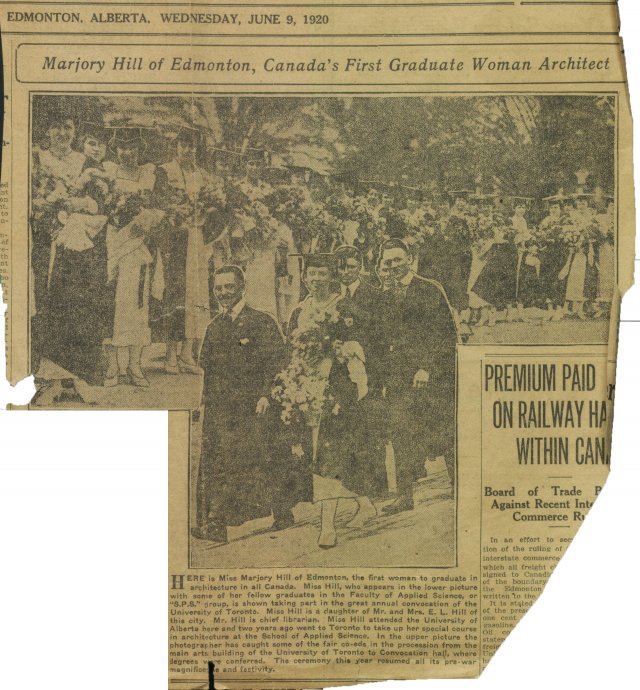“One must have artistic talent, practical experience, professional knowledge, good business and executive ability, resourcefulness, and a determination to persevere. With these assets there is no reason why a woman should not be as successful as a man.”
Esther Marjorie Hill, Toronto Star, June 15, 1920
Esther Marjorie Hill, a Guelph native, holds the distinction of being the first woman in Canada to receive a university degree in architecture (1920) as well as being the first registered female architect in Canada (1925). Her education and professional development coincided with the Canadian women’s suffrage movement. Her entry into the profession was significantly later than women pioneers in other countries, including the U.S.A. where Louise Blanchard Bethune registered as a member of the American Institute of Architects in 1888 and the U.K. where Ethel Charles became an architect in England in 1898.
Daughter of Jeannie Stork Hill, who was one of the first 11 women to study at the University of Toronto and a member of the National Council of Women, Esther Marjorie Hill began studies in architecture at the University of Alberta but transferred to Toronto when the program was cancelled in 1918.
On June 4, 1920 Hill crossed the stage of Convocation Hall at the University of Toronto to become the first woman in Canada to receive a university degree in architecture. While many celebrated the occasion, including the national press, others were not overjoyed. Missing from convocation was C.H.C. Wright, chair of the department of architecture, who protested her graduation by refusing to attend the ceremony.

After receiving her degree, Hill found work as an interior designer at the Eaton’s department store. She eventually returned to Edmonton where in 1921 she applied to become a member of the Alberta Association of Architects. Her application was denied after the Association introduced a new requirement demanding one year of full time experience in an architecture firm. Hill responded by finding a position as a drafter at MacDonald and Magoon, Architects, in Edmonton, before moving in 1923 to New York City to complete a summer design course at Columbia University and work for American architects Marcia Mead and Katherine Budd.
In 1925 she applied a second time for registration with the Alberta Association of Architects. This time she succeeded, becoming the first registered female architect in Canada. Following her registration, she returned in 1928 to MacDonald and Magoon, Architects, where she worked on projects such as the Edmonton Public Library.
Nineteen Twenty-nine marked the beginning of the Great Depression and architectural work was scarce. In another demonstration of perseverance, Hill used her architectural skills to generate income in unusual ways including designing and making greeting cards with a hand-press, as well as creating made-to-measure gloves. It was in this period where she also learnt the art of weaving. Weaving would play an important role in Hill’s professional development since she met many of her clients through it.
In 1936 Hill moved with her family to Victoria, BC, where she founded her own architectural practice specializing in housing. Her first commission in Victoria was the conversion of a single-family house to a duplex in 1940. After registration with the Architectural Institute of British Columbia, she designed several apartment buildings and Glenwarren Lodge (1962), the first elderly care home in Victoria.
Throughout her professional life Hill never abandoned the crafts she learnt during the Depression. She became a member of the Victoria Weaver’s Guild and in 1942 won first prize for her weaving work at Toronto’s CNE. She also had a strong sense of social responsibility, dedicating five years of service to Victoria’s Town Planning commission.
Below: Toronto Star Article published June 12, 1920.
 Sources:
Sources:
Grierson, J., & For The Record Committee (Toronto, Ont.). (2008).
For the record: The first women in Canadian architecture. Toronto: Dundurn Press.
Adams, A., & Tancred, P. (2000).
Designing women: Gender and the architectural profession. Toronto: University of Toronto Press.
Pedwell, Susan.
"Canada’s First Female Architect". U of T Magazine. University of Toronto. Retrieved 21 July 2013.
Forster, M. (2011).
100 more Canadian heroines: Famous and forgotten faces. Toronto: Dundurn.